|
Car Musings: Automotive Thoughts and Opinions (2021 - Part 1)
I remember an accident from 1946 or so. We were riding with another family in their car when the driver hit another car. It was a minor fender bender but the wife hit the windshield, was bleeding and had to go to the hospital for stitches. The late-'30s or early '40s four-door sedan was drivable, so they drove to the hospital. I remember waiting in Nazareth Hospital's yellow-tiled corridors for the woman to be treated and released. My parents and I were in the back seat along with the couple's little girl who was about my age. She and I were playing on the floor when the accident happened and were hit on our heads by wrapped gifts that flew off the rear package shelf. We were not injured.
I never heard of kids falling out of a moving car - and I knew a lot of kids growing up. There were four first grade classrooms at St. Matthew's grade school and each class, including mine, had 109 students. (posted 5/18/21, permalink)
When You Lower A Shoebox Ford, People Notice:
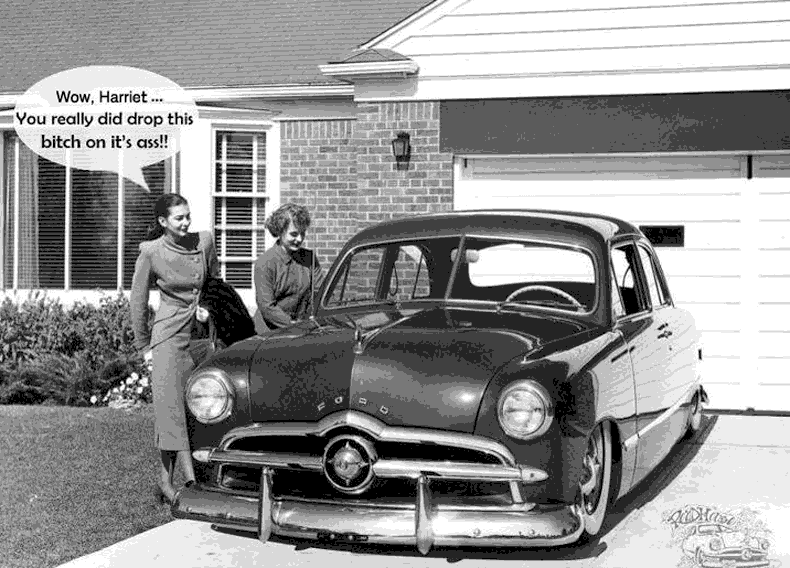
The Ford in the photo is a '49. The 1949 to 1951 Ford models were known as "shoebox Fords" because of their relatively unadorned slab sides. When I was in high school, I'd see lots of shoebox Fords in school parking lots - they were cheap to buy, easy to fix, replacement parts were plentiful and lots of hop-up parts were available for the flathead V8 engine.
Most of these old Fords were Works In Progress, with Bondo, primer, mufflers held on by bent-up wire coat-hangers, etc. But these aging steeds were a tribute to the commitment and ingenuity of their youthful, car-crazy owners just like the Model As and '32-'34 Fords were to the prior generation. (posted 5/14/21, permalink)
No Bull: A 1947 Chrysler Town and Country with the head of a steer mounted on the nose was once owned by actor Leo Carrillo, who played Pancho in 'The Cisco Kid'.
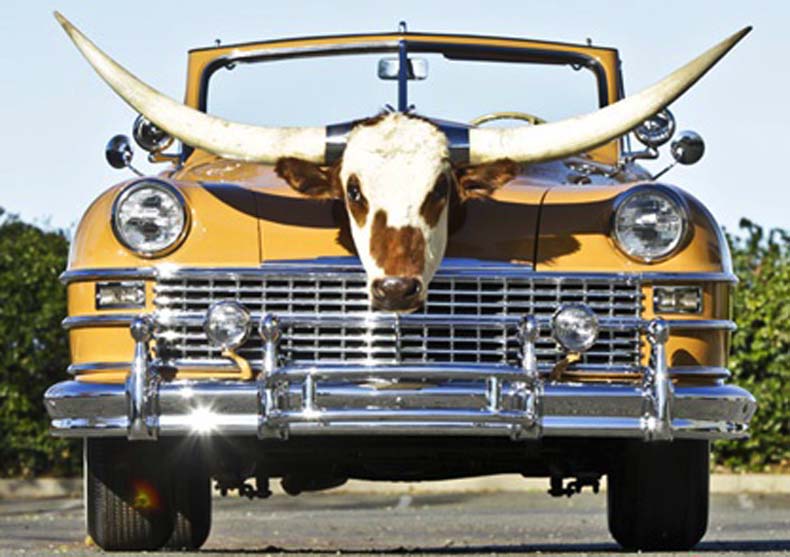
The car had several notable features ... (more >>>)
Cars Without Stories ... or ... Dead Objects, Living Memories: Physical things have their own utility - a car as transportation, a dwelling as a place to live - but also evoke memories within us. The memories may be associated with the object but are not an integral part of it.
Grace Houghton, associate editor at Hagerty, wrote: "Cars are dead-eyed without their stories, but the irony has always been that those stories are far less durable than the physical object, harder to preserve and rebuild, with less attention generally paid to their maintenance. Which makes sense, really; you have to work at that sort of thing." ... (more >>>)
Dress To Match Your Car: That's apparently what this woman did, capturing the horizontal chrome on the side of her 1958 Oldsmobile:
On the other hand, these ladies took a much different approach:
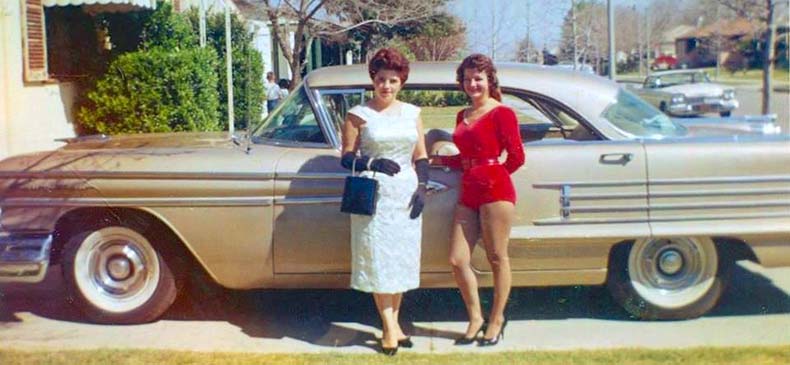
(posted 5/6/21, permalink)
Book Review: '1970 Maximum Muscle: The Pinnacle of Muscle Car Power' by Mark Fletcher and Rich Truesdell
When I first saw the title of this book, I wanted to punch somebody. 1970? Are you kidding? But then I began to read the book and calmed down. I would have thought that 1967-68 was the muscle car pinnacle. Certainly, there had been Shelby Mustangs since 1965, the Chevy Camaro debuted in the 1967 model year as did the Z/28 performance version. The Pontiac GTO was introduced in 1964 and got more powerful every year. As did the Olds 442.
The Buick Skylark Gran Sport appeared as a performance package in the 1965 model year. The AMC Javelin debuted in late '67, the AMX appeared a few months later. On the other hand, the Pontiac GTO 'The Judge' wasn't introduced until 1969 and the Dodge Challenger didn't appear until the 1970 model year. And, although the cars of 1970 were bigger, fatter and more federally-regulated than cars of 1967, they had far more powerful engine options and there were more of them. So, I'd say that the authors made a compelling case for their pinnacle pick.
Certainly by the mid-70s, muscle cars - and cars in general - were a joke. Horsepower was curtailed and performance was lame. Starting with the 1973 models ... (more >>>)
Seventies Ugly: The Truth About Cars published one of its Rare Rides reports on the 1975 Jensen GT.
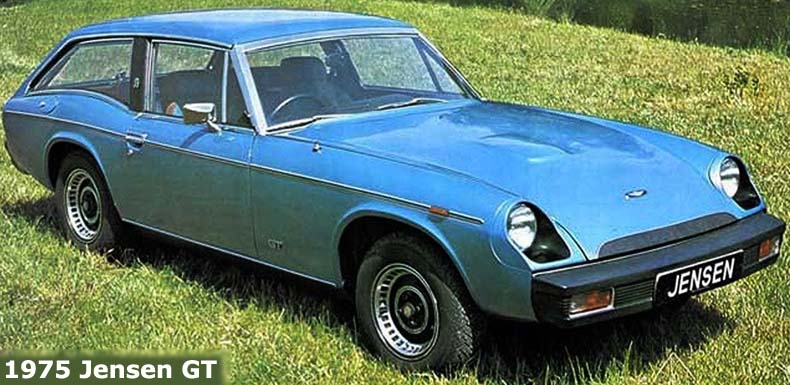
Only 511 Jensen GTs were produced before the company went bankrupt and production ceased in 1976.
The front-end of the Jensen is the poster child for what was wrong with 1970s car designs. Beginning with the 1968 model year, U.S. lighting regulations banned the use of covers on sealed-beam headlamps. If you were looking for smooth aero lines, flip-up headlights were the only solution. Some manufacturers offered tunneled lights as seen on the Jensen. Chevy Vegas, Camaros and other cars appeared with the same sort of tunneled light housings.
Starting with the 1973 models, all cars sold in the U.S. were required to have impact-resistant bumpers which could withstand a 5-mph hit without damage. For the first couple of years, most cars looked atrocious, sporting big black rubber bumper guards or big chrome bumpers that stuck waaaay out from the body of the car. U.S. suppliers quickly developed paintable flexible plastic trim that had sufficient heat resistance to survive auto manufacturers' paint ovens as well as elastomers which could be colored to match the car's body and could incorporate either chrome or plastichrome trim.
American cars handled the bumper regulations best. Many European manufacturers, with smaller budgets and less sophisticated elastomeric technology, stuck with black rubber front ends into the late 1970s. That's what Jensen did. Another case in point was the squarish Volvo 265, introduced in the 1975 model year. Jeremy Clarkson described the Volvo's bumper as looking "like the bottom lip of Forrest Gump's mate Bubba."
In the home market, Europeans didn't have to worry about impact bumpers or SAE-spec sealed-beam headlights. The Euro-spec offerings were often much better-looking. (posted 4/26/21, permalink)
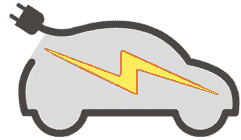 Range Less Than Advertised: British auto writer Neil Winton recently drove the Jaguar iPace battery-electric crossover. He observed, "As soon as an electric car gets close to highway cruising speeds the available range disappears at an alarming rate. The I-Pace for instance has an effective motorway range of only 125 miles, despite its claim for 292 miles overall. I couldn't get more than 253 miles from my home charger. Knock off the recommended 20% to avoid long-term battery damage, that leaves about 200 miles. At European normal highway cruising speeds – often 130 km/h or 80 mph in Europe, slightly less in Britain - the I-Pace delivers about 73.25% of the promised range according to my test, so that leaves around 150 miles. A sensible driver would start looking for a charge point with say 50 miles left, so deduct 25 to be generous, leaving 125/130. My recent time with a Polestar 2 showed it had only about 90 miles of effective range and shed promised miles at about 41% of the claimed available rate." Range Less Than Advertised: British auto writer Neil Winton recently drove the Jaguar iPace battery-electric crossover. He observed, "As soon as an electric car gets close to highway cruising speeds the available range disappears at an alarming rate. The I-Pace for instance has an effective motorway range of only 125 miles, despite its claim for 292 miles overall. I couldn't get more than 253 miles from my home charger. Knock off the recommended 20% to avoid long-term battery damage, that leaves about 200 miles. At European normal highway cruising speeds – often 130 km/h or 80 mph in Europe, slightly less in Britain - the I-Pace delivers about 73.25% of the promised range according to my test, so that leaves around 150 miles. A sensible driver would start looking for a charge point with say 50 miles left, so deduct 25 to be generous, leaving 125/130. My recent time with a Polestar 2 showed it had only about 90 miles of effective range and shed promised miles at about 41% of the claimed available rate."
Neil concluded by asking readers to "try and cast your mind forward to the summer of 2022, when there are more than a million electric cars in Europe. … The highways to the south will be so packed, there will even be queues for ICE cars at filling stations. Would you rather be in a pure electric car, or a plug-in hybrid, as you motor south with the family? Will you measure the time spent traveling south in a BEV in hours or days?" Good question.
In 2009, we took a 12-day driving trip to Montana, putting over 2,300 miles on our Lexus LS 460. The car averaged 23.8 mpg on the trip. On the final leg, which was mostly Interstate travel at 75 mph, it posted 26.4 mpg. Not bad for a big V8-engined sedan. We gassed up whenever and pretty much wherever we wanted. Each fill-up took five minutes or less. How could we make such a trip in a BEV? How many charge stations are in, say, Cut Bank, MT? Or in Flathead County? (posted 4/22/21, permalink)
 2021 Consumer Reports Annual Auto Issue: 85 years ago, Consumer Reports began publishing car-testing results with a report on 22 models in the June 1936 issue. Each car in the group sold for under $800 ($12,550 in 2011 dollars). 2021 Consumer Reports Annual Auto Issue: 85 years ago, Consumer Reports began publishing car-testing results with a report on 22 models in the June 1936 issue. Each car in the group sold for under $800 ($12,550 in 2011 dollars).
CR deemed 17 of them acceptable, and judged the Ford V8 Standard and the Plymouth De Luxe to be Best Buys for their low prices and good performance. The Pontiac De Luxe 6 (tricky handling), Willys 77 (poor visibility and ride), and Auburn 654 (high price and rough engine) were rated Not Acceptable.
In 1936, Consumers Union couldn't afford to buy cars; staffers borrowed them from friends and family. Consumers Union began as a socialist organization in the 1930s and was once declared a subversive organization by the House Un-American Activities Committee. They still come off as a bunch of anti-capitalist lefties sometimes but Consumer Reports magazine remains the most comprehensive and believable of vehicle reliability surveys. This year's issue seemed to offer fewer data and more opinion than in prior years.
CR's database comes from vehicles owned by subscribers who fill out Consumer Reports' annual survey. Cars which are awarded the coveted Top Picks or Buy Recommendation now only need to score 'average' in reliability. Unfortunately, the database of vehicles has shrunk from 1.3 million vehicles in 2011 to less than 330,000 in 2021. Either their number of subscribers is shrinking or people are less willing to fill out their lengthy survey form - or both.
Here are some highlights from this year's auto issue:
• I continue to be astounded by the range of vehicles to choose from these days. I once fancied myself as a car guru who knew exactly what a vehicle was when someone mentioned it. Now I don't even recognize some of the model designations. What the hell is a Hyundai Nexo? Or Subaru Ascent?
• Despite the variety of models, most vehicles - especially SUVs - look the same. Whatever happened to individuality and style?
• CR has now added a green leaf icon to designate those vehicles which are environmentally friendly.
• Consumer Reports now is pitching its annuity plans: 'Receive secure income from a Trusted Partner'. Based on their apparently dwindling subscriber base, I'm not sure this is such a good idea. But I'm not a big fan of annuities anyway.
• There are some vehicles which have dismal reliability but owner satisfaction is quite high. There are some obvious ones, such as the Alfa Romeo Giulia, Jeep Wrangler and Tesla Model Y. But some unexpected cars, with poor reliability but high owner-love include the Audi E-Tron, Genesis G20, Lincoln Nautilus, Aviator and Corsair.
• On the other hand, there are vehicles which CR doesn't rate too badly but owners don't like them very much. They include the Acura ILX, Buick Encore, Infiniti Q50, Nissan Altima and Kicks.
• Some vehicles are just awful - poorly-rated by Consumer Reports and having dissatisfied owners. The list includes the Cadillac XT4, Chevrolet Malibu, Fiat 500X as well as Jeep Renegade and Compass.
• The magazine lists how vehicle brands stack up overall, based on performance, reliability and owner satisfaction. The top five spots are held by Mazda, BMW, Subaru, Porsche and Honda. The bottom spots were awarded to Alfa Romeo, Land Rover, Mitsubishi, Jeep and Lincoln.
• CR's predicted most reliable vehicles: Audi A4, Chevrolet Bolt, Dodge Challenger, Honda Clarity, HR-V & Insight, Hyundai Kona, Infiniti Q50, Jeep Gladiator, Kia Telluride, Lexus GX 460, NX & UX, Mazda CX-3, CX-5 and MX-5 Miata, Toyota 4Runner, Corolla, Prius and Prius Prime.
• CR's predicted least reliable vehicles: Alfa Romeo Giulia & Stelvio, Audi E-Tron & Q7, Cadillac XT4 & XT6, Chevrolet Malibu & Silverado, Dodge Durango, GMC Sierra, Fiat 500X, Ford Escape & Explorer, Jeep Renegade & Compass, Kia Forte, Niro, Niro EV & Soul, all Land Rover models, Lexus LX500, Lincoln Aviator, Corsair & Nautilus, Maserati Ghibli, Mercedes-Benz GLE450 & GLS450, Subaru Ascent, Tesla Model Y, Volkswagen Jetta & Atlas and Volvo S90.
• Amazingly, for a Fiat-Chrysler product, the Dodge Challenger has a much better than average reliability. I guess that, after 13 years, they've finally worked out all the bugs. On the other end of the scale, every Land Rover, Alfa Romeo and Maserati model had much worse than average reliability.
• Surprisingly the latest version Lexus LS flagship sedan got pretty dismal ratings from CR. It has much worse than average reliability and fairly low owner satisfaction. Consumer Reports said it was noisy and not very nimble, didn't handle bumps well and had overly complex controls. The previous generation - the one I own - had great reliability and comfort and was highly rated by CR. As were Lexus LS models from 1990 until the current model.
I still put some stock in Consumer Reports' vehicle survey data analysis, although I am troubled by their shrinking database. Nevertheless, I recommend that you pick up a copy of the April issue for reference while it's still available. (posted 4/12/21, permalink)
Book Review: 'Dodge Viper: The Full Story of the World's first V10 Sports Car' by David Zatz
The Dodge Viper is a specialty sports car manufactured by Chrysler Corp. and its successor companies from 1992 through 2017, having taken a brief hiatus in 2007 and from 2010 to 2012. Over its lifetime, about 31,500 Vipers were produced. By comparison, Chevrolet often produces that many Corvettes in a single year.

The Viper was publicly unveiled in concept form at the January 1989 Detroit Auto Show. It was intended to be a basic no-bones roadster - a modern interpretation of the 1960s-era Shelby Cobra - and was powered by a large aluminum-block V10 engine. Public reaction was so strong that a business case was quickly developed to put the car into production. Using 'skunkworks' tactics, the production version was developed for a relatively low cost of $85 million. Customer deliveries began in early 1992.
The first generation Viper was ... (more >>>)
Small Town, Small Dealer: When Henry Ford ramped up production of his Model T Ford in 1913 and lowered prices sales soared. In 1914, Ford produced more cars than all other automakers combined. By 1918, half of all the cars in the US were Model Ts. Henry aggressively expanded his dealer network, signing up lots of locations in small farming communities.
Soon, Ford's network of local dealers made the car ubiquitous in virtually every city in North America. A large part of the success of Ford's Model T stems from the innovative strategy which introduced a large network of sales hubs making it easy to purchase the car. Some of Ford's earliest dealers still exist and have grown into empires. Others disappeared during the Great Depression. Still others remained small, making a decent living from returning customers.
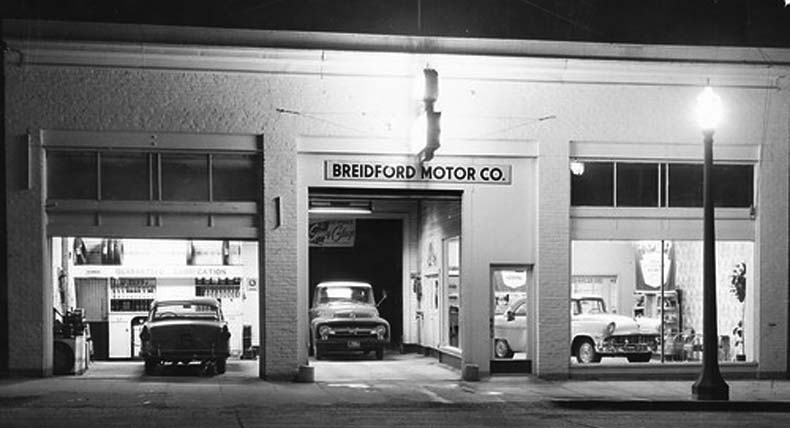
At Briedford Motor Co. in Lynden, WA, a 1956 Fairlane Tudor sedan with Thunderbird emblems on the side - indicating the 312 cubic-inch V8 underhood - occupies the small showroom, while a F-100 pickup blocks out the back shop. Another 1956 Ford is in the open service bay, possibly waiting for an oil change and lube.
Lynden is a small town in Western Washington about 5 miles south of the Canadian border. Current population is now about 14,000 or so. In 1956, when the photo was taken, Lynden had just over 2,000 residents. The city was established in 1874. At one time, Lynden claimed to hold the world record for most churches per square mile and per capita. The Lynden Raspberry Festival is held annually during the third weekend in July. (posted 4/2/21, permalink)
AutoSketch: 1957 Chrysler 300C - Motorized Dynamite
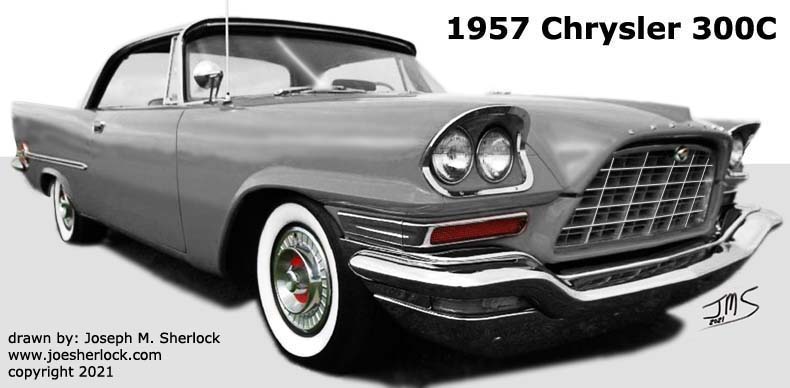
If you want to start a friendly argument among car enthusiasts, ask when the first muscle car appeared on the scene. While the term it self came into being in the 1960s, around the time the first Pontiac GTO arrived - one could readily argue that the first postwar muscle car appeared in the 1955 model year, when the Chrysler C300 was introduced. Given that a muscle car is a standard-bodied production car with a big powerful engine, it could be argued that the very first muscle car was the 1936 Buick Century. This Buick used the shorter and lighter Buick Special body with a large engine from the bigger Roadmaster and Limited models, giving the Century more performance. Buick named it 'Century' because it supposedly had a top speed of 100 mph.
Getting back to the Chrysler 300 series cars, the first ... (more >>>)
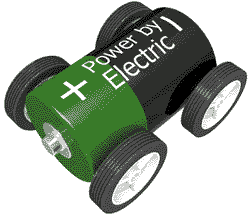 Electric Car Market Share: The electric vehicle market in the United States remained flat in 2020. Estimated all-electric vehicle sales in 2020 were 300,000 with Tesla accounting for almost all of the vehicles sold. Only 2% of all vehicle sales in the U.S. are BEVs (Battery Electric Vehicles). With so many new U.S. offerings in the next year or so, it will be interesting to see if the market share increases substantially in the near future. Electric Car Market Share: The electric vehicle market in the United States remained flat in 2020. Estimated all-electric vehicle sales in 2020 were 300,000 with Tesla accounting for almost all of the vehicles sold. Only 2% of all vehicle sales in the U.S. are BEVs (Battery Electric Vehicles). With so many new U.S. offerings in the next year or so, it will be interesting to see if the market share increases substantially in the near future.
In California, about 8% of all car sales are electric vehicles or plug-in hybrids. In Washington state, 4% of all car sales are from those two categories. Oregon is at 3%. At present, these states represent the three largest U.S. markets for these vehicles.
Electric cars are far more popular in Europe, where people do not travel such long distances, where charging infrastructure is more widespread and where gasoline often costs more than $8.00/gallon. Carmakers sold more than 500,000 battery electric cars in Europe during 2020. One estimate claims that BEVs now represent 20% of all new car sales in Europe.
In Norway, BEVs accounted for 54% of all vehicles sold in 2020. In Germany, sales of electric cars tripled in 2020 to 194,163 units Full-electric vehicles made up 1.2% of all registered passenger cars in Germany. "VW brand led registrations of full-electric cars with a 20.2% share of sales of such models, ahead of Renault with 18.1%, Smart with 11.6% and Tesla with 11.1%." (posted 3/29/21, permalink)
Recalling The Model T Ford With Fondness: Well, not me. I've never driven one or even ridden in one. I did sit in a yellow brass-era Model T roadster for a photo with my friend Ray at the Peterson Automotive Museum during our 2002 Great California Adventure. And for one with my wife during our 2010 visit to the Peterson:
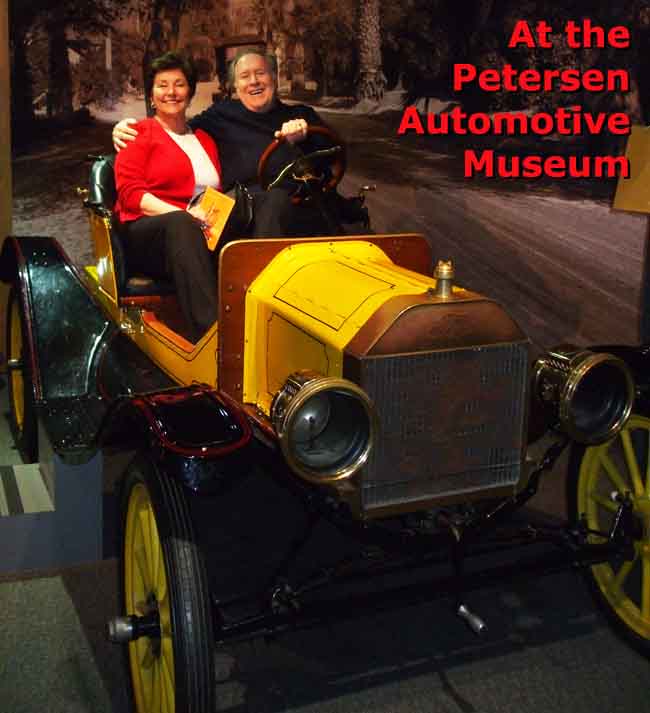
The last Model T rolled of Ford's assembly line sixteen years before my birth and I have no personal connection to Ford's Tin Lizzie. I did however, place it at the top of the list of 'Ten Cars That Changed Everything'.
Writer and children's book author E.B. White - his works included 'Stuart Little' and 'Charlotte's Web' - had a certain fondness for the Model T, and penned an homage in 1936 in the May issue of The New Yorker magazine.
Excerpt: "I see by the new Sears Roebuck catalogue that it is still possible to buy an axle for a 1909 Model T Ford, but I am not deceived. The great days have faded, the end is in sight. Only one page in the current catalogue is devoted to parts and accessories for the Model T; yet everyone remembers springtimes when the Ford gadget section was larger than men's clothing, almost as large as household furnishings. The last Model T was built in 1927, and the car is fading from what scholars call the American scene - which is an understatement, because to a few million people who grew up with it, the old Ford practically was the American scene.

It was the miracle God had wrought. And it was patently the sort of thing that could only happen once. Mechanically uncanny, it was like nothing that had ever come to the world before. Flourishing industries rose and fell with it. As a vehicle, it was hard-working, commonplace, heroic; and it often seemed to transmit those qualities to the persons who rode in it. My own generation identifies it with Youth, with its gaudy, irretrievable excitements; before it fades into the mist, I would like to pay it the tribute of the sigh that is not a sob, and set down random entries in a shape somewhat less cumbersome than a Sears Roebuck catalogue.
The Model T was distinguished from all other makes of cars by the fact that its transmission was of a type known as planetary - which was half metaphysics, half sheer friction. Engineers accepted the word "planetary" in its epicyclic sense, but I was always conscious that it also meant "wandering," "erratic." Because of the peculiar nature of this planetary element, there was always, in Model T, a certain dull rapport between engine and wheels, and even when the car was in a state known as neutral, it trembled with a deep imperative and tended to inch forward. There was never a moment when the bands were not faintly egging the machine on. In this respect it was like a horse, rolling the bit on its tongue, and country people brought to it the same technique they used with draft animals."
"Springtime in the heyday of the Model T was a delirious season. Owning a car was still a major excitement, roads were still wonderful and bad. The Fords were obviously conceived in madness: any car which was capable of going from forward into reverse without any perceptible mechanical hiatus was bound to be a mighty challenging thing to the human imagination. Boys used to veer them off the highway into a level pasture and run wild with them, as though they were cutting up with a girl. Most everybody used the reverse pedal quite as much as the regular foot brake - it distributed the wear over the bands and wore them all down evenly. That was the big trick, to wear all the bands down evenly, so that the final chattering would be total and the whole unit scream for renewal.
The days were golden, the nights were dim and strange. I still recall with trembling those loud, nocturnal crises when you drew up to a signpost and raced the engine so the lights would be bright enough to read destinations by. I have never been really planetary since. I suppose it's time to say goodbye. Farewell, my lovely!" (posted 3/26/21, permalink)
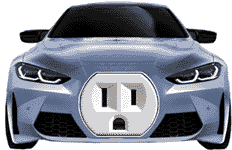 The Shakeout Begins: In the early days of the automobile, there were many companies which raised capital, built a few cars, couldn't compete or make money in a market that had fast-moving technology and consolidation of suppliers dealers and manufacturers. Some were just scammobiles conceived to sucker money out of investors. If you're a car guy with total recall, you may remember long-gone car names such as Abbott, Hayes-Apperson, Duryea, Emancipator, Grout Runabout, Orient Buckboard, Metz, Ultra Motorcar and others. In the early 20th Century, there was no Big Three. Instead, there was the Sorta-Big One Hundred And Three. Or maybe more. The Shakeout Begins: In the early days of the automobile, there were many companies which raised capital, built a few cars, couldn't compete or make money in a market that had fast-moving technology and consolidation of suppliers dealers and manufacturers. Some were just scammobiles conceived to sucker money out of investors. If you're a car guy with total recall, you may remember long-gone car names such as Abbott, Hayes-Apperson, Duryea, Emancipator, Grout Runabout, Orient Buckboard, Metz, Ultra Motorcar and others. In the early 20th Century, there was no Big Three. Instead, there was the Sorta-Big One Hundred And Three. Or maybe more.
History appears to be repeating itself in the electric vehicle industry. It seems like every day, another electric car company has been formed. Some of them are in trouble. Nikola was probably the first. Hindenburg Research, the same firm that outed Nikola last year, recently issued a very negative report on Lordstown Motors.
The research firm wrote, "Lordstown is an electric vehicle SPAC (Special Purpose Acquisition Company) with no revenue and no sellable product, which we believe has misled investors on both its demand and production capabilities. The company has consistently pointed to its book of 100,000 pre-orders as proof of deep demand for its proposed EV truck. Our conversations with former employees, business partners and an extensive document review show that the company's orders are largely fictitious and used as a prop to raise capital and confer legitimacy."
Not surprisingly, Lordstown dissed the report although Chairman and CEO Steve Burns acknowledged that the company is "cooperating" with an inquiry by the Securities and Exchange Commission. The company completed a SPAC merger last year generating $675 million in cash, money it is using to finish development of its new Endurance model.
I distrust that which I don't understand - especially when it seems nonsensical - and I distrust SPACs just as much as I do Bitcoin. I wouldn't be surprised if SPAC really means Secretive Plan to Advance Con-men. SPACs remind me of the pooled investment trusts of the 1920s that were partially responsible for the 1929 stock market crash. Or the Mortgage-backed Securities that contributed to the 2008 crash.
I also don't believe there are thirty-two genders. I don't think gender and race are social constructs devoid of any underlying objective reality. I'm skeptical about the Fish carburetor, too. I don't think someone keeps the recipe for the 100,000-mile tire locked up in a subterranean vault, right next to Walt Disney's head. I believe in one God. And only one kind of Cheerios. I have always believed that Pluto is a planet.
But I digress.
"Former Lordstown employees apparently told the research firm that claims about in-house battery production were bogus, with the equipment necessary for the task still undelivered. This also means the company hadn't tested anything, meaning vehicles that are supposed to start assembly in September haven't been certified by the NHTSA as compliant with Federal Motor Vehicle Safety Standards."
More from Hindenburg Research: "Our research has revealed that Lordstown's order book consists of fake or entirely non-binding orders, from customers that generally do not even have fleets of vehicles."
Well, that doesn't sound good. Perhaps it's no coincidence that the former GM plant in Lordstown, Ohio was originally built in 1966 to make compact cars, notably the ill-fated Chevrolet Vega. Maybe the plant is haunted by the ghosts of dead, rusty little Chevies. (posted 3/25/21, permalink)
Two Kings: In this 1950s photo, jazz/pop singer and pianist Nat King Cole squeezed into a tiny three-wheeled Messerschmitt cabin scooter, dwarfed in comparison to the 1953 Cadillac 75 limo in which his entourage is riding. Reportedly, Mr. Cole owned two Messerschmitt dealerships, one in Los Angeles.
The 111-inch long Messerschmitt seated two in tandem and was powered by a Fichtel and Sachs one-cylinder, kick-start motorcycle engine. The two-stroke, air-cooled engine produced 9.5 horsepower, enough to propel the 385 pound vehicle to 50 mph - if you dared. Price at the factory for the KR-175 model was $564 in 1955. Fuel economy was a remarkable 100 mpg.
Speaking of Kings, Elvis Presley owned a Messerschmitt in 1956:
in the above photo, grandfather Jessie Presley looks on as Elvis sits in his little bubble car. (posted 3/22/21, permalink)
Little Cars: This kid is enjoying his 1957 Ford Thunderbird Electric PowerCar:
This miniature T-Bird was made by The PowerCar company of Mystic Connecticut. The firm began making the Thunderbird Jr. line in 1955 and continued through the 1967 T-Bird model year. The fiberglass-bodied '57 Thunderbird Jr. was 76.5 inches long and was powered by a modified Ford starter motor connected to the rear axle via a V-belt. Forward and reverse were selected with a polarity reversing switch; the 6-volt electric car had a top speed of 5 mph. Faster gas-powered models were also available for adult use, such as Shriner parade cars. All of these little cars rode on an all-steel welded chassis complete with functioning head and taillights.
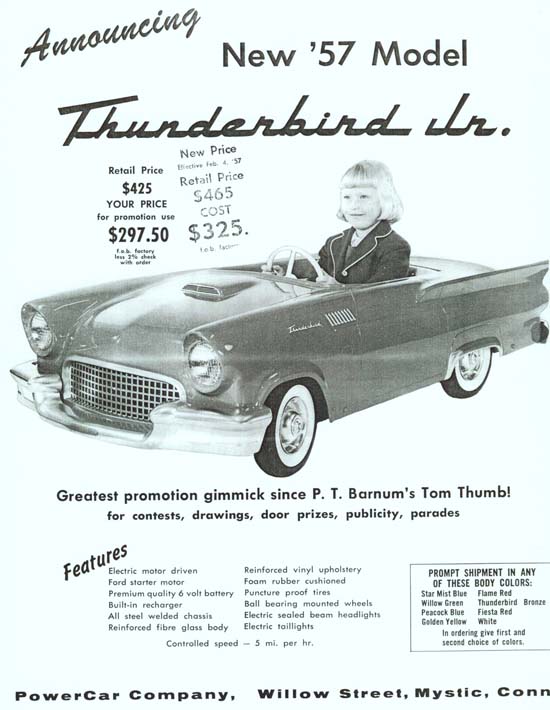
PowerCar Co. made Thunderbird kiddie cars from 1955 to 1967 model years. The firm also offered a '57-'58 Mercury, '58 DeSoto, '58-'60 Plymouth Fury and '65-'67 Mustang models.
In 1967 the assets of the PowerCar Company acquired by Conval Industries. Conval continued to produce the older body styles of the cars for a couple of years but declared bankruptcy in the early 1970s.
More information on miniature powered vehicles, including a '58 Edsel and a 1950s-era Divco Milk Truck can be found here. (posted 3/19/21, permalink)
Book Review: 'Virgil Exner - Visioneer' by Peter Grist
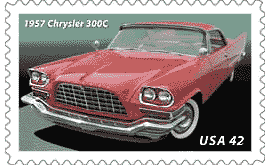 Virgil Exner was a talented designer and stylist, whose work is best known in the automotive field. Working for General Motors in the 1930s, he developed the Silver Streak brightwork first seen adorning the 1936 Pontiac hood. The Silver Streak remained a Pontiac signature style element for over 20 years. He worked at Studebaker during the 1940s - first as an employee of Raymond Loewy - who held the Studebaker design contract - and later as a direct Studebaker employee. Virgil Exner was a talented designer and stylist, whose work is best known in the automotive field. Working for General Motors in the 1930s, he developed the Silver Streak brightwork first seen adorning the 1936 Pontiac hood. The Silver Streak remained a Pontiac signature style element for over 20 years. He worked at Studebaker during the 1940s - first as an employee of Raymond Loewy - who held the Studebaker design contract - and later as a direct Studebaker employee.
While Loewy always claimed credit for his employee's work, it is generally acknowledged that Exner deserves much of the credit for the radical 'Which Way Is It Going?' 1947 Studebaker design - a three box, mostly slab-sided style with pontoon rear fender which was quickly copied by other automakers. After working for Loewy for several years, Exner came to despise him for his slave-driving attitude and usurping credit for the work of others.
Virgil Exner began working for Chrysler, where ... (more >>>)
 The Decline Of Gas Stations: You've probably noticed that there are far fewer gas stations than there used to be. They were once called service stations but today most of them offer little or no service - you pump your own gas (except in Oregon and New Jersey), clean your own windshield, check your oil yourself and pump up your tires, if needed. The Decline Of Gas Stations: You've probably noticed that there are far fewer gas stations than there used to be. They were once called service stations but today most of them offer little or no service - you pump your own gas (except in Oregon and New Jersey), clean your own windshield, check your oil yourself and pump up your tires, if needed.
These days, most gas stations have a convenience store where the wash and repair bays used to be. Until the late 1970s, auto repair was a good sideline for station owners. Cars needed frequent oil changes, chassis lubrication and engine tune-ups. Fixing flat tires was a brisk and steady trade until the advent of self-sealing tubeless tires.
Many service stations also sold tires (as well as radiator hoses, fan belts and batteries) and some could even arrange for an engine or transmission rebuild through an affiliated local firm. Attendants and mechanics looked official with brand-centric work uniforms and caps - some were military-style.
Today's gas stations are of a similar generic design, with distinctive bright coloring to indicate the brand of fuel sold. In the 20th Century, starting in the 1930s through the 1960s, stations used eye-catching architecture to differentiate themselves from competitors. Some were shaped like teapots or jugs (there was a jug-shaped station which still dispensed fuel in 1980s Junction City, Oregon), and later some with tall lighted towers constructed of glass block.
Called programmatic architecture, these stations assumed the fanciful shape of animals, apples, tea kettles, tepees, windmills, castles, icebergs, and airplanes. Appealing to the curiosity of passing motorists, programmatic stations were inspired by local culture, distinctive local materials, or ... (more >>>)
Grand Opening: In November, 1964, Bob Brown took out full-page ads, proclaiming that he was the proud new owner of an Oldsmobile dealership at SE Grand Avenue and SE Yamhill Streets in Portland, Oregon.
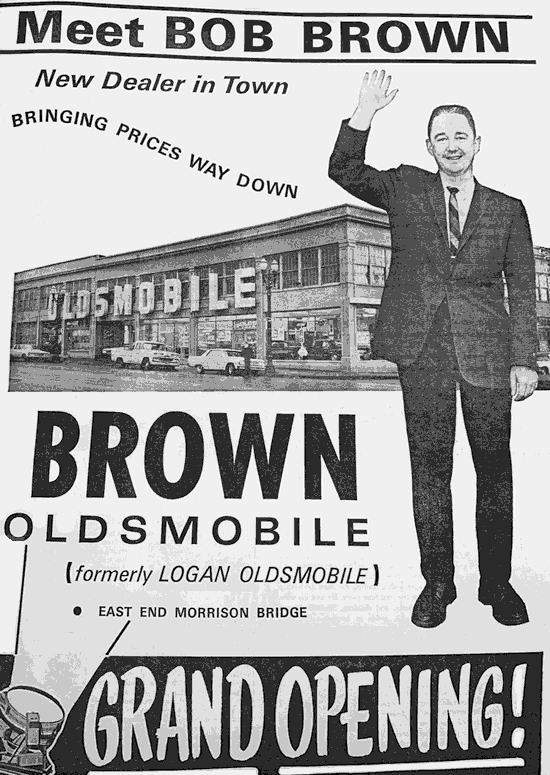
By the mid-1970s, Bob Brown Oldsmobile had added Subarus to its showroom. The exterior was now renovated with backlit acrylic pan signage which was all the rage at the time.
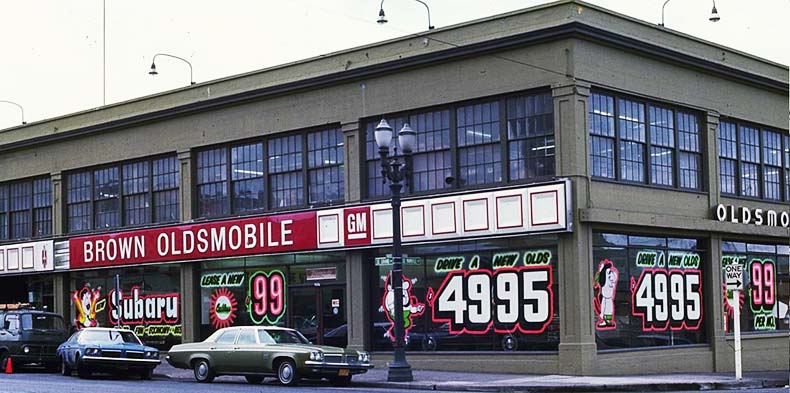
Bob stopped selling Oldsmobiles in 1988. The building now houses a boutique furniture and crafts store. (posted 3/11/21, permalink)
Book Review: Corvette Stingray - The Mid-Engine Revolution
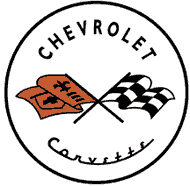 This just-published book lists Chevrolet as the author; it is a company-sponsored publication, with a foreword by General Motors president Mark Reuss. Don't let that scare you off - it is an honest book which reveals many of the trials and tribulations of trying to get a high-performance, mid-engined, reasonably-priced sports car to market. It took 50-plus painful years to achieve. This just-published book lists Chevrolet as the author; it is a company-sponsored publication, with a foreword by General Motors president Mark Reuss. Don't let that scare you off - it is an honest book which reveals many of the trials and tribulations of trying to get a high-performance, mid-engined, reasonably-priced sports car to market. It took 50-plus painful years to achieve.
The book documents many of the pitfalls - the battles between Zora Arkus-Duntov and various Chevrolet managers and GM executives over the years, as well as the sidetracking caused by Ed Cole's fascination with the ill-fated Wankel rotary engine. (In the early '70s, I saw my first and only NSU Ro 80, the Wankel-engined, technologically-advanced German sedan parked in front of the General Motors Technical Center in Warren, MI.) Arkus-Duntov retired in 1975 at age 65 but he continued to consult for General Motors, after a brief fling with the ill-fated DeLorean automobile.
To keep the costs down, Chevy didn't use a supercar-like carbon fiber tub for the mid-engined Vette. Everything is made of aluminum (much of it high-pressure die cast), except ... (more >>>)
Postal Ugly: I'm old enough to remember those 'safety cars' of yore - from the 1950s through '70s - designed and underwritten by a government safety group or some insurance company. I don't know whether they were actually safe, but all of them had one thing in common: they were butt-ugly. This is why cars should be designed by car designers, not disinterested committees.
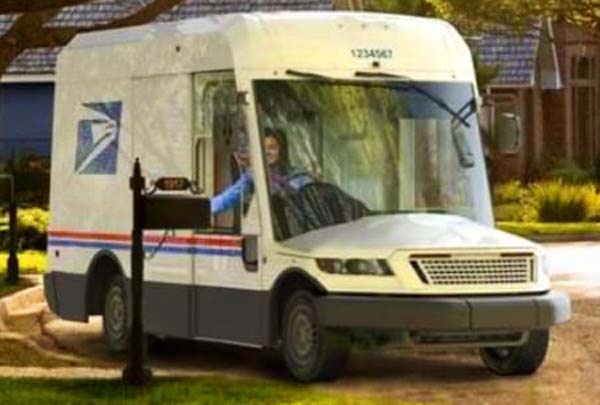
The 2021 new USPS delivery van is a perfect example of this axiom. It is hideous. And costly. Yes, you can say that America's Postal Service is an "independent entity," but it loses lots of money every year and, like Amtrak, has Uncle Sugar make up the difference. So, for all intents and purposes, it's a gummint bureau.
"Oshkosh Defense to manufacture a new generation of postal delivery vehicles. Under the initial $482 million investment, Oshkosh Defense, a unit of Oshkosh Corp., will finalize the production design, testing and vehicle tooling necessary prior to vehicle production. The contract, which could be worth more than $6 billion in total, allows for delivery of between 50,000 to 165,000 of the vehicles over 10 years that will be a mix of internal combustion-powered and battery-electric vehicles." That translates to a cost per vehicle of between $36,400 to $120,000 each. Knowing how the government works, the figure is going to be closer to the highest number. You could buy close to half-a-dozen Subarus for that kind of money.
For over 30 years we had an independent postal carrier. She was efficient and reliable. She drove a right-hand-drive Subaru Outback wagon. She loved it - it was comfortable, reliable and didn't hinder her ability to deliver mail in any way. (posted 3/9/21, permalink)
 The Truth About Microchips: It's a well-known fact that automakers treat suppliers like crap. They are very demanding, slow-pay and prone to cancel contracts when business slumps. The Truth About Microchips: It's a well-known fact that automakers treat suppliers like crap. They are very demanding, slow-pay and prone to cancel contracts when business slumps.
The semiconductor market is big and broad and many chipmakers have decided they don't need the hassle of dealing with car companies. "The car sector has been used to the fact that the whole supply chain is centered around cars," said McKinsey partner Ondrej Burkacky. "What has been overlooked is that semiconductor makers actually do have an alternative."
Smartphones, video games and other consumer electronics applications require more sophisticated chips than automotive semiconductor applications and that means higher prices and more profit for chipmakers. "The auto industry spends around $40 billion a year on chips - about a tenth of the global market. By comparison, Apple spends more on chips just to make its iPhones, Mirabaud tech analyst Neil Campling reckons."
In summary, the semiconductor crunch that has battered the auto sector in recent times leaves carmakers with stark choices: pay up (higher prices, faster payment of invoices), stock up (increase finished chip inventory at the auttomaker's facility) or risk getting stuck on the sidelines as chipmakers focus on more lucrative (higher-margin) business elsewhere. (posted 3/1/21, permalink)
AutoSketch: 1952 MG TD - England Comes To America
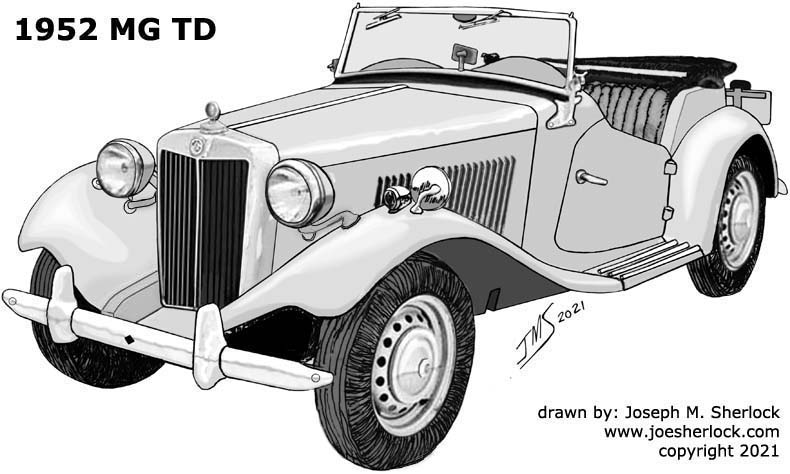
MG traces its lineage to 1895, when William Morris started a bicycle repair business in a shed at the back of his parents' house. He soon moved on to automobiles and named his firm Morris Garages, later known as MG. While MG produced sedans, it is best known for its sports cars.
After the war, MG introduced the TC, a small sports car. While it found markets in South Africa and elsewhere, it was not designed for the North American market. It was offered in ... (more >>>)
Nice Eyes: Anyone remember Moon Racing Equipment?
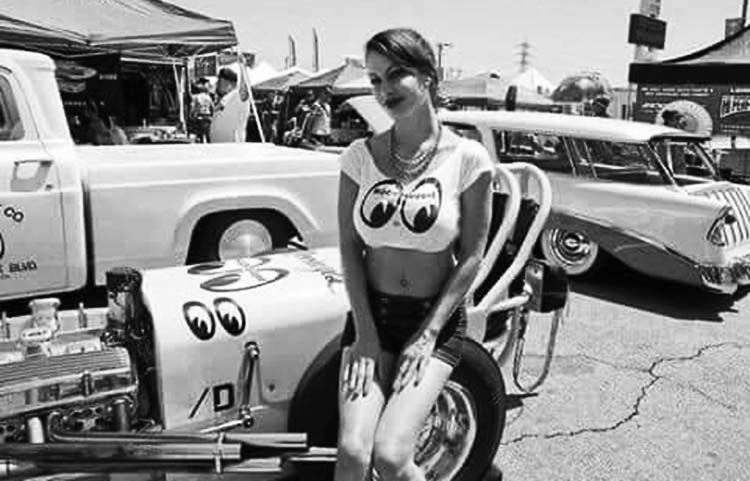
This may be the best-looking example of their T-shirts I've ever seen. Here's a couple of additional contenders:
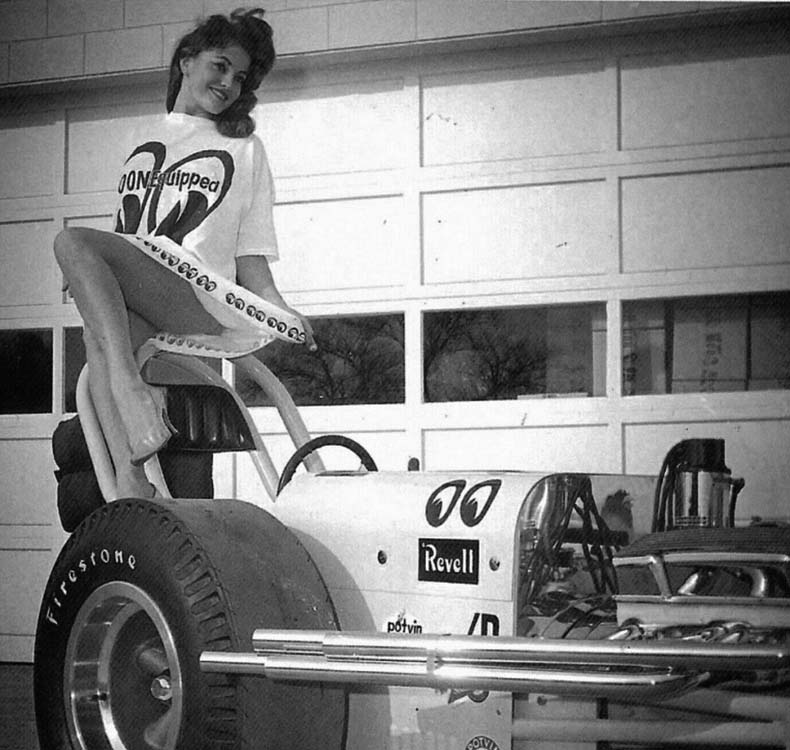
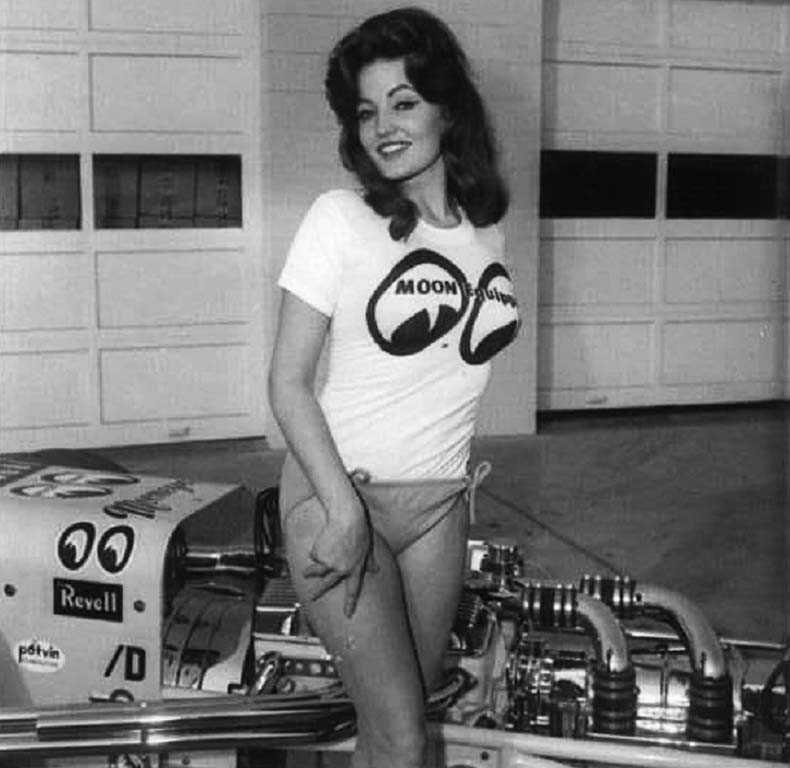
Bottom photo was taken in April 1964. (posted 2/23/21, permalink)
Now Riding The Eternal Dune: Bruce F. Meyers, engineer and developer of the famous - and much copied - Meyers Manx dune buggy, has died at age 94. Bruce built the first commercial VW-based dune buggy in 1964. Meyers was also a surfer, sailor, guitar/ukulele player, artist, engineer and founding father of the entire off-road lifestyle and industry. Born on March 12, 1926, he was inducted into the Off-Road Motorsports Hall of Fame in 1978.
Meyers Manx eventually produced over 7,000 cars but succumbed to a massive knock-off industry that built over 350,000 copies from some 300 companies worldwide. Bruce never got a dime in royalties from these firms.
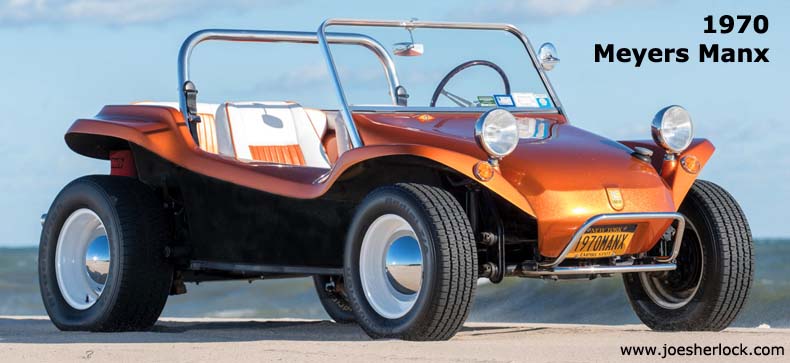
One of the more memorable buggies was the customized Manx used by Steve McQueen in 'The Thomas Crown Affair'. It has been fully restored and was sold in March 2020 for $456,000. McQueen's Manx was customized for the film, and originally featured a 2.7-litrer flat-six from a Chevrolet Corvair, along with recessed headlights and a quilted cabin. Oh, and two levers to brake either the left or right rear tires for trick driving. The film was released in 1968 and featured a number of cool vehicles, including the reddish-orange dune buggy.
I met Bruce once at his office/factory in the early 1970s; he was a personable fellow. Sadly, he was more of an artist and idea guy rather than businessman. RIP. (posted 2/23/21, permalink)
 Poor Sales, No Loyalty: The latest Consumer Reports owner satisfaction survey is out. Infiniti, the luxury arm of Japan's Nissan, took the bottom position this year. Poor Sales, No Loyalty: The latest Consumer Reports owner satisfaction survey is out. Infiniti, the luxury arm of Japan's Nissan, took the bottom position this year.
"The score on the study is based on a potential total of 100. Tesla ranks first with a score of 88. Infiniti, in last place, had a score of 48, just ahead of its parent Nissan, which had a score of 58." Infiniti is the worst-selling luxury brand in America - behind Lexus, Mercedes, Audi, BMW, Acura, Cadillac, Lincoln, Land Rover and Volvo, as measured by unit sales.
Fifteen years ago, Infiniti scored relatively well on CR's reliability survey. In recent years, it has gotten a reputation for poor quality. Infiniti has struggled ever since its botched 'rocks-n-trees' introduction in late 1989. It never established a consistent brand image and sales have suffered because of that. Marketing seems to range from peripatetic to nonexistent.
In 2020, Infiniti performed miserably, falling to 10th place in luxury brand sales and selling only 79,503 vehicles in the U.S. For every Infiniti sold last year, 3.5 Lexus models found buyers. In 1999, Infiniti sold 72,637 cars; in 2009, the brand sold 70,808 vehicles. See a trend here? Or a lack of one?
Infiniti is now trying a Hail Mary pass - the 2022 Infiniti Q60 crossover has been restyled and is equipped with a 295 horsepower V6 coupled to a nine-speed automatic transmission. "The upcoming, all-new 2022 Infiniti QX60 embraces the tenets of what our brand stands for," said Infiniti Chairman Peyman Kargar. "Teams from Japan and the U.S. have worked tirelessly to bring the new QX60 to customers as our most refined and advanced three-row crossover yet. The QX60 is a foundation for Infiniti and will bring to life our core philosophies." Pricing is expected to be around $50,000 for a decently-equipped example. Well, I guess Kagar has got to start somewhere but this may be as ineffective as putting a pinkie Band-Aid on a massive sucking chest wound.
Meanwhile, Tesla, Lincoln, and Ram led the most-liked rankings, while Cadillac, Nissan, and the aforementioned Infiniti rode the bottom. Fixing Infiniti requires fixing Nissan, a Herculean task - as unpleasant and challenging as cleaning the Augean stables.
Automotive Content Specialist for Consumer Reports Mike Quincy noted that "some brands with a high owner satisfaction rating - such as Tesla and Lincoln - have many models with below-average reliability. So, even with their flaws, many car owners are still happy with their choices.
This year, Tesla scored highest on the survey with owners rating their cars a four or five out of five for driving, comfort, and in-cabin electronics. No matter how you feel about Tesla, you have to know that Tesla owners are completely smitten with their cars. Lincoln and Ram, the second and third-place brands on the survey, may not generate the same level of adoration, but owners are showing a great deal of satisfaction with their purchases. That, in turn, translates to repeat sales and positive word of mouth."
Quincy also noted that it's not the expensive brands racking up the points. BMW is ranked 13th, Lexus 19th, and Mercedes-Benz 23rd. (posted 2/19/21, permalink)
Cool Idea: Here's a Scion customized to resemble a classic VW Microbus:
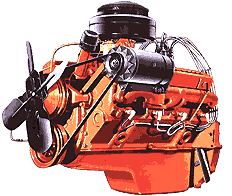 How To Differentiate? Historically, Toyota engines are generally-known for their reliability. Honda motors are known for their technical excellence and creative engineering approach. How To Differentiate? Historically, Toyota engines are generally-known for their reliability. Honda motors are known for their technical excellence and creative engineering approach.
The old small-block Chevy V8 is over-engineered and bulletproof; it has enough excess metal that it can be easily bored-out and hopped-up.
Ferrari engines are works of art and contain almost all the ICE bells and whistles that excite enthusiasts. Chrysler 318 engines last and last while the bodies of their host cars rust away.
Car enthusiasts understand the multiples in price commanded by a Hellcat Hemi, a Ferrari V12 or a vintage Offy motor. But electric engines and batteries are pretty generic. You can slap a Ferrari emblem and some nice Metallic Rosa paint on the powertrain's exterior case, but inside it's just another electric motor. Will AMG make motors with an engraving of Helmut Kunstalter's signature - he's the guy who ran the armature-winding machine - on the case and expect people to pay a premium? Will Bentley offer a certificate of guarantee that they employed special 'curated' lithium for their batteries?
The question must be asked: Will a Lamborghini electric motor command a large multiple over a Nissan Leaf electric motor? If not, how will consumers be persuaded to prefer one electric powerplant over another? How will marketers create mythology to support their product's ordinary and ubiquitous powertrain? After all, one synchronous AC motor is pretty much like the next.
I don't know the answers, but it will be interesting to watch.
It's not just about marketing problems with electric vehicles. Jack Baruth recently wrote an article for Hagerty, titled 'What if you held a mandatory EV party and nobody came?' It's a good question because, as of this writing, EVs account for only 1% of U.S. vehicle sales.
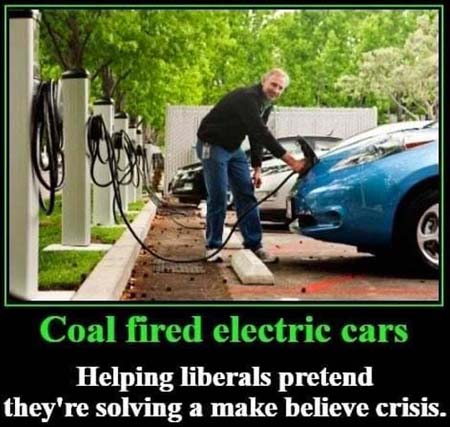
Jack ponders what will happen if all the promised technical breakthroughs in battery technology never happen - and there's a lot of evidence that they won't. "Instead, we get maybe a safer and more efficient gel battery, or something like that. The cost of EVs is still 25% higher, at minimum, than the cost of ICE equivalents. Charging takes 15–20 minutes for 500 miles, assuming you can afford the 500-mile version of the car. Winter is a problem, serious winters doubly so. There's a significant and perhaps unpredictable decline of battery performance over time, making used cars basically worthless in the long run. (Remember, the average car is 11 years old, an age at which a Nissan Leaf or Chevy Bolt is not all that distinguishable from a macro-scale paperweight.) The service infrastructure is a nightmare, because there are several different battery technologies in production." Good luck with all that.
What if people just don't want electric cars? Go back to 1973, when the government shoved safety/pollution regulations down prospects' throats - resulting in cars with big ugly 5-mph bumpers and engines that wouldn't run worth a damn due to crude emissions equipment of the era. Light vehicle sales nosedived for the next three years and they began to fall long before the '74-'75 economic recession. I know of quite a few people who kept their pre-1973 cars and just fixed them up as needed, even though they could have easily afforded a new vehicle. Auto sales didn't make a permanent comeback until the mid-1980s.
Electric vehicles may turn out to be less popular than the Sacagawea dollar coin. (posted 2/15/21, permalink)
New Prius Feature: Prius now offers virtue signaling built-in.
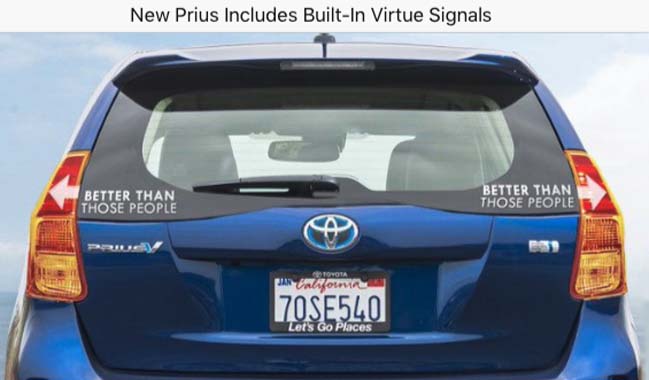
Parody site Babylon Bee reported that this "exciting new model of Toyota's popular Prius hybrid vehicle will eliminate all turn signals and replace them with a large virtue signal."
"The car will feature a lighted signal spanning the rear of the trunk, which will flash several messages when activated. The base model simply says 'Better Than Those People', while custom options include messages like 'Doing My Part', 'Environment First', and 'If Only You Cared About The Earth As Much As I Do'."
"We understand what matters to our drivers," a Toyota spokesperson told reporters. "More than letting other drivers on the road know which direction they are turning, our drivers desperately want to let people know their values are superior to everyone around them at any given moment."
"Toyota expects the shaming message of the virtue signal to distract the public from noticing its rising carbon footprint from the additional energy utilized to build the signal." (posted 2/11/21, permalink)
Edsels By Night: That should be the title of a photo taken shortly after the grand opening of ... (more >>>)
'Manson Before the Storm' is the title of this car-themed painting by ... (more >>>)
Old Ads From Car Magazines: Whenever I look at an old issue of a car magazine, I often look in the back where the columnar display ads reside.
These small ads mostly represented the hopes and dreams of struggling entrepreneurs to develop a market for their products and inventions. These ads were from companies all over the U.S., although many had Southern California addresses.
Perusing ads in the back of old Road & Track magazines, I found ... (more >>>)
AutoSketch: 1952 Continental 195X - Lincoln's First Dream Car
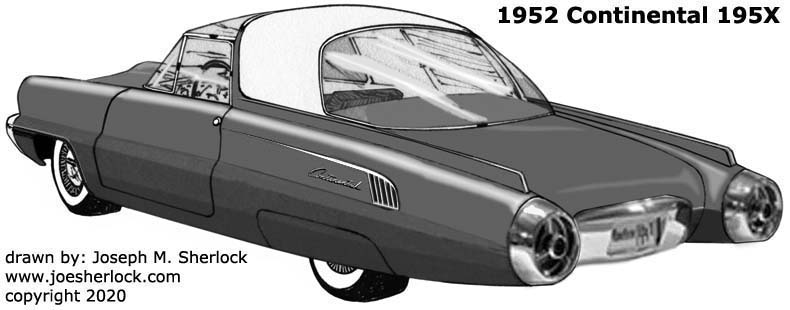
Ford Motor Company used dream cars - now referred to as 'concept cars' - to create interest in their standard offerings and to attract people to their displays at auto shows.
The Continental 195X was Lincoln's first postwar dream car and was introduced at the Chicago Auto Show in early 1952. The five-seater two-door coupe was not a running model, rather a fiberglass and plaster pushmobile. The public received the futuristic vehicle with great enthusiasm. Many were fans of the original Lincoln Continental and were excited that a second version might be forthcoming.
The 195X was designed by ... (more >>>)
This racing Jag "once belonged to British race car driver Peter Blond, and former Led Zeppelin manager Peter Grant, among many others." The factory red color is relatively rare; most D-Jags I've seen are British racing green, silver or Ecurie blue.
A black 1937 Bugatti Type 57SC Tourer with body by Corsica went under the gavel for $4,735,000. A pale green 1957 Mercedes-Benz 300 SL Roadster sold for $1,066,500.
Jesse Bowers posted photos of John Sarkisyan's's idea of what an updated M-B 300SL roadster might be like … not renderings but an actual running car. (posted 1/28/21, permalink)
Motorama Formal: In the early days of the automobile, coachbuilders began to offer a specific bodystyle known as a Town Car, featuring a comfy, closed passenger compartment for the wealthy while providing a basic open compartment for the chauffeur.
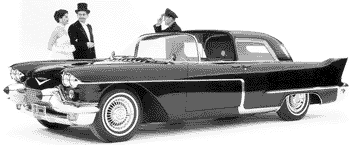 One of the vehicles in the 1956 General Motors Motorama was the 1956 Cadillac Eldorado Brougham Town Car, a one-off concept car done in the traditional Town Car style, featuring an open chauffeur's compartment. As is the case with many one-off dream cars, it was too low to be practical - 55 inches in height - but it looked sleek, riding on a long 129.5-inch wheelbase. One of the vehicles in the 1956 General Motors Motorama was the 1956 Cadillac Eldorado Brougham Town Car, a one-off concept car done in the traditional Town Car style, featuring an open chauffeur's compartment. As is the case with many one-off dream cars, it was too low to be practical - 55 inches in height - but it looked sleek, riding on a long 129.5-inch wheelbase.
The Town Car foretold the styling of the production 1957-58 Cadillac Eldorado Brougham, a four-door hardtop priced at $13,000.
The body of the Caddy Town Car was constructed of fiberglass. It had a half-roof over the passenger compartment which was covered in black leather. It was first seen at the New York City Motorama. The chauffeur's compartment was finished simply in black Moroccan leather and chrome. The passenger compartment was trimmed in gold and upholstered in beige leather in a 'biscuit and button' motif. The flooring is covered in deep-pile Wilton carpeting to match the upholstery. The passenger compartment of the Town Car contained "such items as a radio-telephone combination, air-conditioning equipment, a woman's vanity compartment, cigar humidor and thermos bottle."
Nothing says luxury better than a thermos bottle. (Remember Steve Martin in 'The Jerk'?) It keeps hot things hot and cold things cold. How does it know which is which?
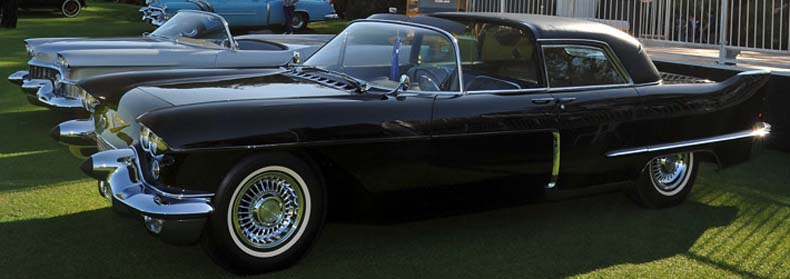
Following New York it went to Miami, Los Angeles, San Francisco and Boston. In October 1956, the Town Car was shown at the Paris Salon, where it drew much acclaim. After the show circuit, the car was consigned to a GM warehouse and was scheduled to be destroyed. But it avoided the crusher and passed through several collectors' hands over the years. In 2012, the Eldorado Brougham Town Car was sold for $258,500 in 2012 at RM Sotheby's auction.
I'm a fan of classic town car style, where the chauffeur is exposed to the elements while the occupants of the closed portion keep warm and sip Moët & Chandon champagne while munching on crudités or caviar. It shows the lesser people who's boss. In 1993, I penned a modern town car based on - what else?! - the Lincoln Town Car.
The Lincoln V12 engine idea - a proper powerplant for a flagship Lincoln - appeared in the 1996 Lincoln Sentinel concept car. It was rumored to be two Taurus V-6 motors joined together. (posted 1/22/21, permalink)
Nice Polish: Here's a 1957 eye-catching ad for Mac's Resin Coat Car Polish:
Introduced at the 'virtual' 2021 Tokyo Auto Show, the Copen Spyder is a tiny kei car-based sporty roadster concept car with a speedster-style half-windshield, headrest fairings, a tiny 63 horsepower engine and Volk Racing TE37 wheels.
The English firm Berkeley Cars Ltd. produced sporty microcars with motorcycle-derived engines from 322 cc to 692 cc and front wheel drive between 1956 and 1960. Less than 130 inches long, the 1958 model was powered by an 18 horsepower engine. Less than 4,000 Berkeleys were produced. (posted 1/18/21, permalink)
Truckin': The shift from sedans and coupes to light trucks, including SUVs, is illustrated by this graph:
2020 Vehicle Sales: According to the Bureau of Economic Analysis, annual light vehicle sales in 2020 were 14.46 million units, down 14.7% from 16.95 million in 2019. This was the fewest annual sales since 2012. The UK reported their largest drop in new car sales since World War II. Thanks, China for sending us the virus that wrecked the world's economy.

General Motors annual U.S. sales were 2,547,339 units, down 12% compared with 2019. (GM delivered 2.9 million vehicles in China in 2020, down 6.2% from the prior year.) Highlights for 2020 included the Chevy Bolt (up 26%), the Blazer (up 63%) and "virtually every truck the company sells under either the Chevy or GMC banners, though the Silverado 1500 series actually fell short of its 2019 volume; GMC's Sierra variants, however, were up across the board." Buick sales fell 21% in 2020 to 162,749 vehicles. Cadillac sales declined 17% to 129,495 vehicles. 1,730,033 Chevys found buyers in 2020 - a drop of 11% from last year.
For calendar year 2020, Toyota Motor reported sales of 2,112,941 vehicles, a decrease of 11%. The Toyota brand dropped 12% to 1,837,898 units for the year. Toyota remained the number one retail brand for the 9th consecutive year. 2020 total hybrid sales increased 23%; Toyota division hybrid sales doubled. The top-selling Toyota in 2020 was the RAV4 - 448,071 examples of this SUV model were sold, a decline of 4% from 2019. The Tacoma captured the mid-size pickup crown - 238,806 were sold in 2020. Sales of Lexus fell by 8% to 275,042 vehicles. The flagship LS experienced a sales drop of 35% to 3,617 sedans.
Ford sales fell 16% to 1,929,195 vehicles for calendar year 2020. Sales of F-Series pickups fell 12%, although Ford claims that the F-Series remains America's best selling pickup with 787,422 sold. Mustang sales fell by 16% last year. Ford Explorer and Ranger were bright spots - Explorer gained 21% and Ranger was up 13%. Sales of Lincoln fell 6% to 105,405 vehicles. Corsair, the small Escape-based crossover, was Lincoln's top-seller in 2020; 6,227 ere sold. SUVs represented 83% of Lincoln's annual sales last year.
Honda sales fell 17% in 2020 to 1,199,805 vehicles, while Acura purchases declined by 13%, with 146,982 vehicles sold. The top-selling Honda model was the CR-V - 333,502 were sold in 2020. The RDX crossover was Acura's best-selling model. 52,785 examples found buyers in 2020, a drop of 16% from last year.
Fiat Chrysler Automobiles N.V. reported total U.S. sales of 1,820,443 vehicles, a decline of 17%. Jeep sales dropped 14% to 795,306 trucks. Ram sales slid 11% to 624,637 trucks last year. Chrysler sales declined 13% to 110,285 vehicles. Dodge dropped 27% to 267,326 units. Alfa Romeo sales were up 2% to 18,294 for 2020. Fiat racked up a dismal 53% decline to 4,304 units for the year. I suspect Fiat will soon depart the U.S. market - it is down to one vehicle offering, the 500X crossover.
Nissan Group announced total calendar year 2020 U.S. sales of 899,217 units, a decrease of 33.2% compared to the prior year. Nissan brand sales dropped a whopping 32% to 837,762 vehicles in 2020. Nissan got hammered because the rental car market fell precipitously due to the virus. The Infiniti brand fared worse - declining 32% to 79,503 units last year.
Hyundai sales slid 10% for 2020 to 618,925 units, while cousin Kia slid 5% to 586,005 units. The Genesis luxury brand found only 16,384 buyers in 2020, a drop of 23%. Genesis' dismal performance isn't due to the quality of its offerings; they have been widely-praised by auto journalists and are generally acknowledged as a great value for the money. But they don't sell well because the brand lacked SUV offerings until recently and because they are perceived as upmarket Hyundais, since they're sold in the same showrooms as the lesser brand.
Subaru sold 611,942 vehicles in 2020, a 13% decrease compared with calendar year 2019.
Mazda sales were up fractionally for the year, selling 279,076 vehicles. The only existing models to improve last year were the Miata sports car (up 14%) and the CX-9 crossover - up 3%.
Volkswagen sales declined by 11% to 323,634 vehicles in 2020, although - worldwide - sales of its electric vehicles tripled. Volvo sales increased 2% with 110,130 units finding buyers last year. Mitsubishi sold 87,386 vehicles, a 28% drop. Mini sales were down 22% to 28,047 vehicles.
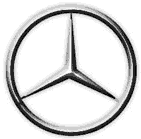 Mercedes-Benz sold 325,915 vehicles in 2020, a drop of 9%. In America, M-B retained its crown as the top-selling 2020 luxury auto brand. The figure does include 50,999 Mercedes-Benz vans, which represents a mix of some luxury van conversions and straight commercial vehicles, so the crown is in dispute. BMW sold 280,297 passenger vehicles in 2020, a drop of 14%. Audi sold 186,620 units in the U.S., falling 17% from 2019. Porsche sold 57,294 vehicles in 2020, down 7% from the prior year. Mercedes-Benz sold 325,915 vehicles in 2020, a drop of 9%. In America, M-B retained its crown as the top-selling 2020 luxury auto brand. The figure does include 50,999 Mercedes-Benz vans, which represents a mix of some luxury van conversions and straight commercial vehicles, so the crown is in dispute. BMW sold 280,297 passenger vehicles in 2020, a drop of 14%. Audi sold 186,620 units in the U.S., falling 17% from 2019. Porsche sold 57,294 vehicles in 2020, down 7% from the prior year.
Jaguar sales fell 30% to 21,786 kitties. Land Rover suffered a sales decline of 15% to 80,034 SUVs. Worldwide, Jaguar and Land Rover vehicle sales fell by 24% in 2020. Land Rover sales were down 18% to 323,480 SUVs while Jaguar fell 37% to 102,484 units. Jaguar Land Rover's 2020 sales were spread across five regions: North America at 25%, China at 23%, the United Kingdom - 20%, Europe - 19%, and the remainder of the world - 13%.
Tesla delivered 499,550 vehicles worldwide in 2020. "Unsurprisingly, the vast majority of vehicles Tesla delivered this year were Model 3 and Model Y vehicles, totaling 442,511 units. Model S and X comprised 57,039 deliveries throughout the year. During the fourth quarter, the split was 161,650 Model 3 and Y units and 18,920 Model S and X vehicles." Tesla doesn't break out U.S. sales but it is estimated that the company sold 260,000 vehicles in the U.S. last year, making them the fourth-largest luxury brand, based on U.S. sales - a remarkable achievement.
Here's a scorecard of various luxury and almost-luxury marques:
| Brand |
2020 sales
|
% change
|
| Mercedes-Benz |
325,915
|
-9%
|
| BMW |
280,297
|
-14%
|
| Lexus |
275,042
|
-8%
|
| Tesla |
260,000e
|
+16%
|
| Audi |
186,620
|
-17%
|
| Acura |
146,982
|
-13%
|
| Cadillac |
129,495
|
-17%
|
| Lincoln |
105,405
|
-6%
|
| Land Rover |
80,034
|
-15%
|
| Infiniti |
79,503
|
-32%
|
| Porsche |
57,294
|
-7%
|
| Jaguar |
21,786
|
-30%
|
| Alfa Romeo |
18,294
|
+2%
|
| Genesis |
16,384
|
-23%
|
In the ultra-luxury class, Bentley did well in 2020, placing 2,895 vehicles in U.S. garages - a gain of 5% over 2019. On the other hand, Rolls-Royce sales fell 26% in 2020 to 1,260 stately vehicles. Lamborghini sales fell 13% to 2,260 sporty cars and utes. McLaren sold 1,440 examples of its supercars last year in the U.S. - a drop of 21%. Maserati sales dropped 35% to 6,132 vehicles.
Summary: It was a trying year but automakers and dealers did better than expected despite the China virus. Every automaker is hoping for a better 2021. As are all of us. (posted 1/13/21, permalink)
Another Christmas Gift: I also received a 1:43 scale model of the 1956 Pontiac Club de Mer, a one-off show car featured in that year's GM Motorama.
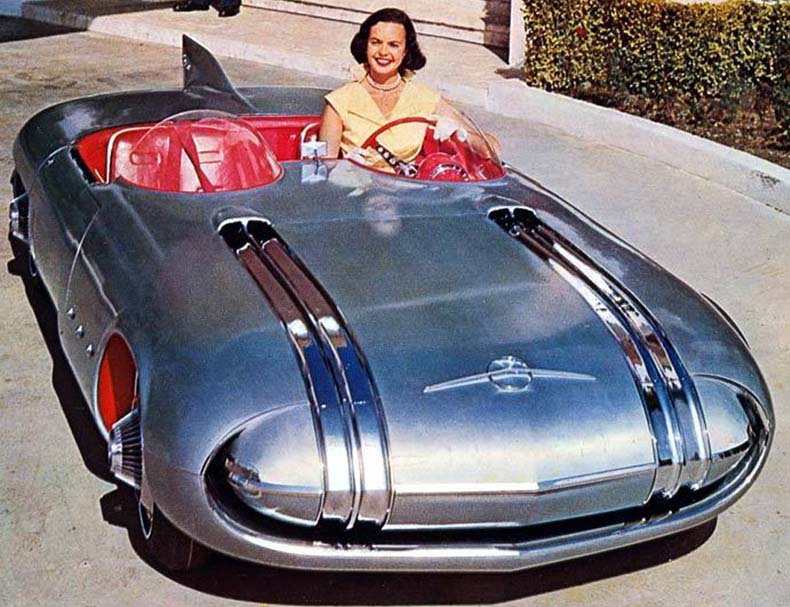
The Club de Mer roadster was reportedly the brainchild of GM Styling VP, Harley Earl, although Pontiac Studio head Paul Gillian was also involved and deserves credit as well. The de Mer was a ... (more >>>)
A Gift From Santa: One of the Christmas gifts I received in 2020 was a 1:43 scale model of a 1948 Cadillac Series 62 with a custom Saoutchik cabriolet body.
This three-Position Cabriolet body by Saoutchik, has painted cane work accents, and ... (more >>>)
Earlier Car Musings can be found here.
Other Pages Of Interest
| blog: 'The View Through The Windshield' |
| greatest hits: index of essays & articles | blog archives | '39 Plymouth |
| model train layout | about me | about the blog | e-mail |
copyright 2021 - Joseph M. Sherlock - All applicable rights reserved
Disclaimer
The facts presented on this website are based on my best guesses and my substantially faulty geezer memory. The opinions expressed herein are strictly those of the author and are protected by the U.S. Constitution. Probably.
If I have slandered any brands of automobiles, either expressly or inadvertently, they're most likely crap cars and deserve it. Automobile manufacturers should be aware that they always have the option of trying to change my mind by providing me with vehicles to test drive. I'll dutifully report my road test impressions on this car blog.
If I have slandered any people or corporations, either expressly or inadvertently, they should buy me strong drinks (and an expensive meal) and try to prove to me that they're not the jerks I've portrayed them to be. If you're buying, I'm willing to listen.
|